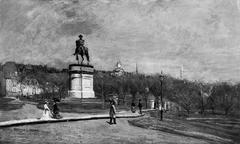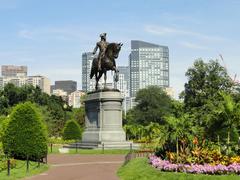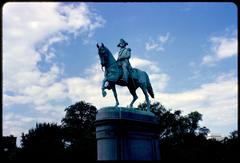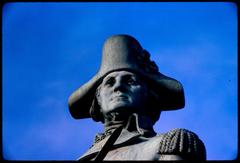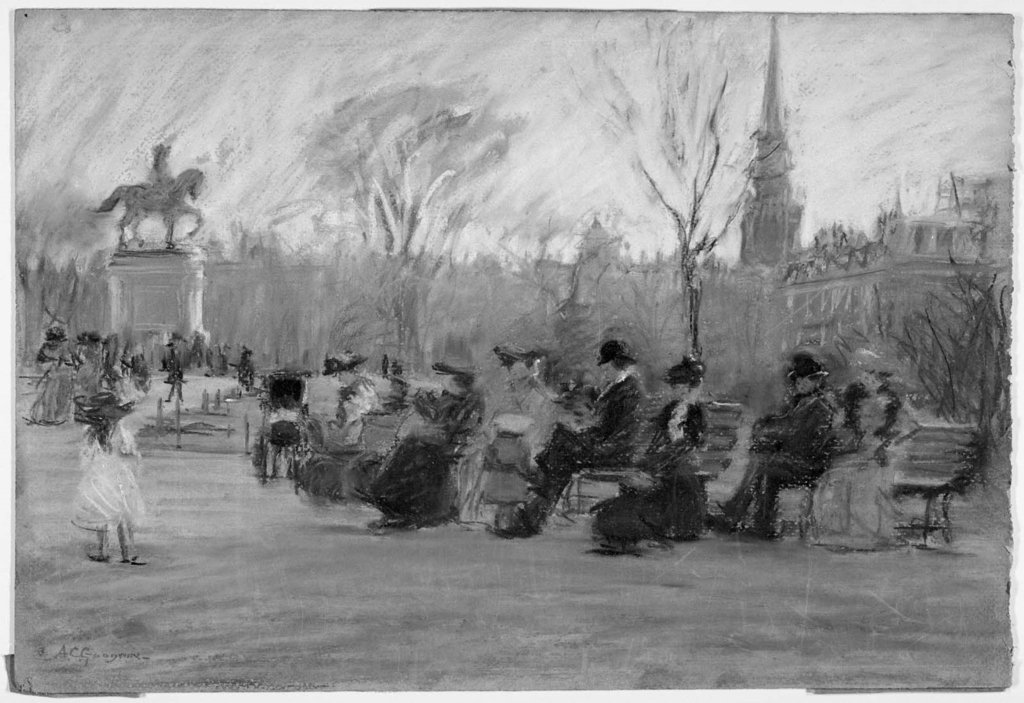
Equestrian Statue of George Washington, Boston: Visiting Hours, Tickets, and Historical Significance
Date: 14/06/2025
Introduction
The Equestrian Statue of George Washington in Boston’s Public Garden stands as an enduring symbol of American heritage, artistry, and civic pride. Created entirely in Massachusetts during the tumultuous Civil War era, this monument commemorates the nation’s first president and celebrates Boston’s commitment to public art and historical remembrance. Situated at the Arlington Street entrance of the Public Garden, the statue greets visitors with a striking visual testament to leadership and unity. This guide offers comprehensive information on the statue’s history, visiting logistics, accessibility, nearby attractions, and preservation efforts, ensuring a meaningful and well-informed experience for every visitor.
Sources: (Boston Parks and Recreation Department), (Smithsonian American Art Museum)
Table of Contents
- Historical Background
- Visitor Information
- Preservation and Community Efforts
- FAQs
- Conclusion and Practical Tips
- References
Historical Background
Origins and Commissioning
Efforts to erect an equestrian statue of George Washington began in 1859, driven by Boston’s aspiration to be a center for American art and civic identity. Unlike many contemporary monuments cast in Europe, this statue was entirely designed, modeled, and cast in Massachusetts. Community fundraising, public subscriptions, donations, and a city fair funded the project, with notable contributions from Robert C. Winthrop and city appropriations. The final cost was around $42,000, with more than half coming from the public (theclio.com), (wikipedia.org), (celebrateboston.com), (theclio.com).
Design and Artistic Vision
Thomas Ball, a Boston native, sculpted Washington in military uniform, avoiding excessive decoration to emphasize humility and leadership. The naturalistic composition of Washington and his horse was praised for its artistic quality and dynamic presence (theclio.com), (equestrianstatue.org).
Casting and Construction
The Civil War delayed the statue’s completion; it was eventually cast by the Ames Manufacturing Company in Massachusetts. Standing 22 feet tall (bronze statue) atop a 16-foot granite pedestal, the monument reaches a total height of 38 feet and rests on a deep-set foundation (celebrateboston.com).
Dedication and Public Reception
The statue was unveiled on July 3, 1869, celebrated with a 13-gun salute and attended by over 100,000 people. It quickly became a Boston landmark and a focal point for civic events (bostoday.6amcity.com), (Boston Public Library).
Symbolism and Interpretations
The statue embodies ideals of patriotism, humility, and leadership. Its equestrian form, traditionally reserved for monarchs, elevates Washington’s stature as a national hero while emphasizing his republican values (National Park Service). Over time, its symbolism has been revisited within broader historical narratives (theclio.com).
Visitor Information
Location and Accessibility
The statue is prominently located at the Arlington Street entrance of the Boston Public Garden, bounded by Charles, Boylston, Arlington, and Beacon Streets. The nearest MBTA subway stop is Arlington Station (Green Line), just a short walk away. Paved, wheelchair-accessible paths lead directly to the statue, and benches are available for rest. The terrain is flat and suitable for strollers and wheelchairs (A View On Cities), (MBTA Map).
Visiting Hours
The Boston Public Garden is open daily from dawn until dusk, year-round. The statue is freely accessible during these hours (Boston Parks and Recreation Department), (Boston Parks Hours).
Admission and Tickets
No tickets or passes are required. Entry is free for all visitors.
Guided Tours and Events
The statue features on many walking tours of Boston’s historic sites, such as the Freedom Trail detour and the Boston Women’s Heritage Trail (Freedom Trail). Special events, including flower festivals and public celebrations, are occasionally held in the garden, especially near the statue during spring and summer (Boston Parks and Recreation events calendar).
Photography Tips
The statue’s southern orientation and elevated granite pedestal make it ideal for photography, particularly during golden hour. The surrounding flower beds—renowned for their spring tulip displays—create vibrant backdrops. Drones are prohibited in the Public Garden; all photography must be ground-based (Boston Drone Policy).
Nearby Attractions
Within walking distance are Boston Common, the Massachusetts State House, Beacon Hill, and the iconic Swan Boats. The Public Garden itself is home to the Make Way for Ducklings statues and historic footbridge (Our Adventure Journal), (A View On Cities), (Swan Boats).
Preservation and Community Efforts
The statue is maintained by the City of Boston and the Friends of the Public Garden, who oversee regular cleaning and conservation. These efforts ensure the monument remains in excellent condition for future generations (bostoday.6amcity.com), (Friends of the Public Garden).
Frequently Asked Questions (FAQ)
Q: What are the visiting hours?
A: The statue is accessible during the Public Garden’s hours, from dawn until dusk, daily.
Q: Is there an admission fee?
A: No, entry is free.
Q: Is the statue wheelchair accessible?
A: Yes, paved and accessible paths lead directly to the statue.
Q: Are guided tours available?
A: Yes, the statue is included in many walking tours of Boston’s historic sites.
Q: Can I take photographs?
A: Yes, personal photography is encouraged; commercial shoots require a permit. Drones are not allowed.
Q: Where can I park?
A: Metered street parking is available nearby; accessible parking is offered at the Boston Common Garage (Boston Common Garage).
Q: Are there restrooms or food vendors?
A: Restrooms are available at the Boston Common Visitor Information Center; many cafes and restaurants are nearby on Newbury and Boylston Streets.
Conclusion and Practical Tips
Visiting the Equestrian Statue of George Washington offers a unique opportunity to engage with Boston’s historical, artistic, and civic legacy. The statue’s accessible location, free entry, and proximity to other notable Boston landmarks make it an essential stop for history enthusiasts, photographers, and families alike. For the best experience, visit during spring or fall, utilize public transport, and explore the surrounding garden and nearby attractions.
Practical Tips:
- Visit early morning or late afternoon for optimal lighting and fewer crowds.
- Respect the site by not climbing on the statue or pedestal.
- Check the weather and dress accordingly; the garden is open year-round.
- Download the Audiala app for self-guided audio tours and up-to-date visitor information.
Plan your visit to experience this remarkable symbol of American leadership and Boston’s enduring civic spirit.
References
- The Clio: Visiting the Equestrian Statue of George Washington in Boston: History, Hours & Tips, 2024
- Wikipedia: Equestrian statue of George Washington (Boston), 2024
- Celebrate Boston: Public Garden Washington Statue, 2024
- Boston Today: Learn about the Equestrian Statue of George Washington in Boston’s Public Garden, 2024
- Equestrian Statue Organization: Equestrian Statue of George Washington, 2024
- Boston Parks and Recreation Department, 2024
- Boston Art Commission: Equestrian Statue of George Washington, 2024
- Smithsonian American Art Museum: George Washington, 2024
- National Park Service: Equestrian Statue of George Washington, 2024
- Boston Public Library: The Equestrian Statue of George Washington in the Public Garden, 2024
- Our Adventure Journal: Boston Common and the Public Garden, 2024
- A View On Cities: Boston Public Garden Overview, 2024
For further planning, consult the official Boston Public Garden website and Boston USA tourism portal.

